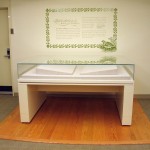 After almost a year (we began this journey last November), the permanent display area for our amazing set of John James Audubon’s Birds of America is finally complete.
After almost a year (we began this journey last November), the permanent display area for our amazing set of John James Audubon’s Birds of America is finally complete.
Next week, we will begin turning the pages (every Monday–or if it’s a holiday–Tuesday), and Trinity will get to see a new bird every week for the next 8 years or so. I will likely be blogging about some of the more well-known or quirky ones, but hopefully we’ll start to see some regulars coming in just to see the new bird! The turkey (plate I) was on display all summer, so we’ll give the poor fellow a rest (especially since Thanksgiving is around the corner). But here’s a pic of him (with a volume of the Library of America edition of Audubon’s works shown for scale):
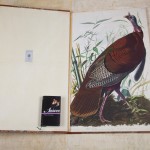 Mark your calendars for THURSDAY NOVEMBER 3rd, the official opening of this permanent exhibit. Dr. Christoph Irmscher, English professor at Indiana University and editor of the collection of Audubon’s works just mentioned, will be delivering a lecture on the production of the Birds of America over twenty years–it’s a grand tale indeed. There will be a “review” of the four volumes in the Watkinson Reading Room from 4:00-5:00pm, and the lecture will start at 5:00 in the Joslin Family 1823 Room (Library Level 2).
Mark your calendars for THURSDAY NOVEMBER 3rd, the official opening of this permanent exhibit. Dr. Christoph Irmscher, English professor at Indiana University and editor of the collection of Audubon’s works just mentioned, will be delivering a lecture on the production of the Birds of America over twenty years–it’s a grand tale indeed. There will be a “review” of the four volumes in the Watkinson Reading Room from 4:00-5:00pm, and the lecture will start at 5:00 in the Joslin Family 1823 Room (Library Level 2).
Tags: Exhibitions
Comments Off on Audubon exhibit area is finished–whew!
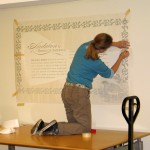 Today we added the final design element to the wall behind the Audubon case. The decorative border (and the bird) came from a source contemporary with Audubon–a book of specimens that a printer would show a client who was looking to publish a book, like sales samples, which we found in the wonderful D. B. Updike collection on printing at the Providence Public Library:
Today we added the final design element to the wall behind the Audubon case. The decorative border (and the bird) came from a source contemporary with Audubon–a book of specimens that a printer would show a client who was looking to publish a book, like sales samples, which we found in the wonderful D. B. Updike collection on printing at the Providence Public Library:
Specimen of Printing Types and Ornaments, from the Type and Stereotype Foundry of William Hagar and Co. (New York: [s.n.], 1841).
Shown here is Melissa, the installer from the sign company (ArtFX).
My fabulous designer, Arley-Rose Torsone, took this little bitty ornament and the bird (which is the size of a quarter), did her magic, and produced a design that the sign company then fabricated into vinyl.
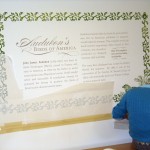 It really pops–the text has a much more finished look, and the frame draws the eye to it.
It really pops–the text has a much more finished look, and the frame draws the eye to it.
Now we just have to get the floor finished, and we’ll be ready to go!
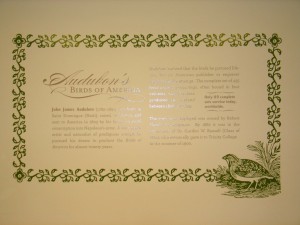
Comments Off on Audubon wall, stage II
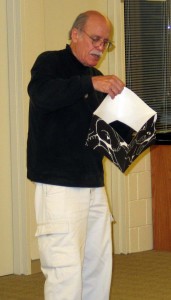 Printmaker and artist Werner Pfeiffer visited the Watkinson last night to speak to students in Erin Valentino’s First Year Seminar on post-9/11 art and Jonathan Elukin’s History of the Book course.
Printmaker and artist Werner Pfeiffer visited the Watkinson last night to speak to students in Erin Valentino’s First Year Seminar on post-9/11 art and Jonathan Elukin’s History of the Book course.
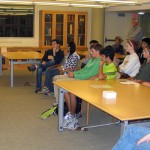 Werner constructed his work entitled “Out of the sky” as he spoke about where he was on 9/11 (crossing a bridge into Manhattan–he saw the second plane hit) and how the project took shape in his mind and through his hands over the next five years.
Werner constructed his work entitled “Out of the sky” as he spoke about where he was on 9/11 (crossing a bridge into Manhattan–he saw the second plane hit) and how the project took shape in his mind and through his hands over the next five years.
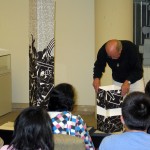 The towers, depicting names of the the victims and images of falling bodies, girders, and steps, are made up of 36 prints carved into 18 blocks of wood–blocks that Werner carved himself, a relief process that involves cutting away what one does not wish to see in the print.
The towers, depicting names of the the victims and images of falling bodies, girders, and steps, are made up of 36 prints carved into 18 blocks of wood–blocks that Werner carved himself, a relief process that involves cutting away what one does not wish to see in the print.
The act of building the towers and taking them back down is intended as a kind of birth, life, and death of the memory of the tragedy. You open it up to remember and reflect, and you close it down and put it away to move on.
In a small booklet Werner listed the victims from all four planes and the sites they struck.
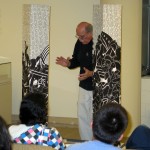
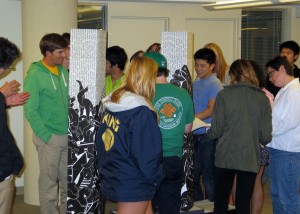 Werner always designs hands-on productions, and he encouraged the students to handle the towers, and even help take them down.
Werner always designs hands-on productions, and he encouraged the students to handle the towers, and even help take them down.
Comments Off on Book Artist @ the Watkinson
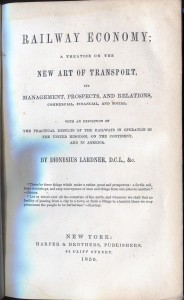 Railway Economy: a treatise on the new art of transport (New York, 1850).
Railway Economy: a treatise on the new art of transport (New York, 1850).
According to the dealer’s description, this is the first edition of possibly the most comprehensive book ever written on railways. The author, Dionysius Lardner (1793-1859) was an Irish-born professor, polymath and prolific writer on astronomy, economics, natural philosophy, and electricity.
Lardner begins with a brief history of transportation through the ages and then focuses on trains, providing many tables and statistics. He leaves out no detail of railway systems in America, Europe, and the U.K., from the cost of building particular lines, to the operation of the boilers, to the behavior of passengers in stations, to the odds of being killed per mile traveled. He concludes with a chapter on the politics of railways, a discussion similar to those of today relating to funding of ownership of roads and the Internet.
Tags: New Acquisition
Comments Off on All Aboard! Newly acquired book on railroads
 Today we added the final design element to the wall behind the Audubon case. The decorative border (and the bird) came from a source contemporary with Audubon–a book of specimens that a printer would show a client who was looking to publish a book, like sales samples, which we found in the wonderful D. B. Updike collection on printing at the Providence Public Library:
Today we added the final design element to the wall behind the Audubon case. The decorative border (and the bird) came from a source contemporary with Audubon–a book of specimens that a printer would show a client who was looking to publish a book, like sales samples, which we found in the wonderful D. B. Updike collection on printing at the Providence Public Library: It really pops–the text has a much more finished look, and the frame draws the eye to it.
It really pops–the text has a much more finished look, and the frame draws the eye to it.







